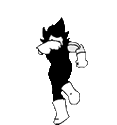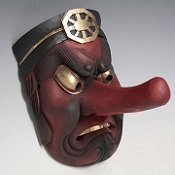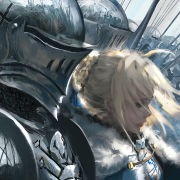|
Dragonmech: Magic poo poo The drow have developed magical engines that run on the blood of the living, draining it from captives. (The dwarves actually captured one of these and found a way to duplicate it nonmagically, but have outlawed it entirely.) A similar device, a variant spell furnace, can power a mech by draining the magic out of extraplanar or magical beings. Very nasty, but not too weird. One of the weirder ones is the ethereal catapult - a magically enchanted catapult meant to pierce mech armor. It turns its stones into ethereal matter when launched, which transform back after breaching their designated target. This makes it attack via touch AC, not that it's going to miss a mech at all - the big thing is, they bypass all hardness and have a threat range of 17-20 due to manifesting inside the target. In theory, any weapon could use the enchantment, but so far it's just catapults. Or you could make an intelligent, self-aware steam engine by the same process that intelligent weapons are made. If you do, and then put that steam engine in a mech, it can pilot the mech without any human assistance. There are a few sentient mechs out there as a result - most notably, one that hunts orcs after its creator was killed in an orcish raid. This sitll isn't the weirdest magic item - and neither are the speaking engines, which are steam engines with magic mouths cast on them with conditions to speak under certain mechanical conditions, such as an overheating boiler or gears out of alignment. It makes diagnosing problems easier. Nah, the weirdest is the elven experimental design: magnetized ring gates. They have yet to be deployed in battle, but they're very promising. They're a lot like three-foot diameter ring gates from the normal DMG, but one is anchored onto a mech. The other gets hurled out of a catapult. It's enchanted to magnetically staple itself to the first metal thing it touches - usually a mech. Once that happens, the power is activated. See, you can pass anything through the one gate to emerge out of the other, through any wall it's attached to - so you can send a boarding party into the enemy mech without even piercing the hull. Or you can throw grenades through. The elves have very high hopes for these things, but they do have problems. They are extremely difficult to make, requiring a 17th level caster, and they're not exactly easy to use, either. You can also enchant mechs directly. Elves like to throw up Protection from Arrows against other mechs, while dwarves prefer Protection from Elements against elven forces due to their preference for fireball wands. Famously, one mech battle was won due to a mech being enchanted with the ability to use Rusting Grasp. This generally requires the Combine Spell feat and multiple casters, because mechs are stupidly big.  Now, let's talk about the world. Strictly speaking, the planet is DragonMech - or, rather, has many names and the game's narration text calls it that. Highpoint is the continent where all gameplay takes place, however. Only Highpoint has developed mechs - the other continents are just basically hosed by the lunar rains and the monsters from the moon. The reason it's called Highpoint is because of the tides. The oceans of the world rise and fall by over 30 feet each year due to massive temperature swings at the poles, which freeze and melt arctic ice regularly. The moon has also hosed with tidal patterns, making it even bigger. As a result, pretty much no settlements exist near waterways, as the coastlines shift wildly over the course of a year. This is part of why so many surface races were nomadic. Before the lunar rains, amphibious races dominated the world. Even now, the amphibious races and their half-underwater settlements aren't too rare, and there are amphibious variants of all the normal races, on top of other weirdos. Trade routes ae also highly seasonal, as they are often underwater for large portions of the year. Highpoint's name comes from the fact that, on average, it has the highest distance above sea level. It's actually a bunch of plateaus with a mountain range on top, with only the lowest plateau, the western Wet Desert, going underwater for half the year. (The other half, it's a salty desert.) Historically, the eastern coastline has been tall enough that no floodwaters could ever breach it, though since the rains began, that hasn't been quite true. Most of Highpoint is temperate or warm, getting cooler and wetter as one goes east. The northern forests are more tropical (and wet), and the southern swamps are also pretty wet, but the west is pretty dry, even in high-water months. The southern tip of the continent is colder than the rest, but still broadly temperate. Highpoint recognizes only two seasons - high-water and low-water, which broadly are spring/summer and autumn/winter respectively. The water isn't rain - it's flooding from the river that splits the continent or the ocean surrounding it. The west suffers it more heavily than the east, with mostly lakes and rivers expanding in the east. The east does get snow in the latter half of low-water, but the west rarely gets rain or snow at all. The most common form of timekeeping is the Duerok system of the dwarves, largely because most human tribes don't actually use a set system at all. The dwarven system divides the year into seven months, each of six weeks, each of six days, for a total of 252 days per year. The first day is Diggon, traditionally the day in which delves began and a day of general communal activity. It remains so on mechs, though digging isn't really a thing that happens there. The second day is Axon, the day of martial training and still used on many mechs as the day of fighting drills. The third day is Digget, which is like Diggon. The fourth day is Suron, and it (and the two following days, Suret and Surol) are dedicated to personal labor. In the past, Surol was a day of rest, but that tradition ended with the lunar rains. The seven months are Arie (approximately spring, when the waters are at midpoint), Cammerce (as the waters rise and traditionally a month of trading and travel), Highwater (as the waters peak), Duerok (the month of holidays, when all dwarven holidays happen - one each week - to honor the dwarven virtues of Thrift, Discipline, Clan, Honor, Strength and Valor), Flero (the waters begin to recede), Jealo (the cold time when nothing is growing and stores are being depleted) and Lowwater (when the waters are at their weakest ebb). The moon has approached close enough that it can sometimes take up as much as 3/4 of the sky and is visible even by day, though the moon does follow a regular cycle. While parts may be shaded, the entire surface is still visible, and on full moons, the night as near as bright as day. The rains have calmed some since they begin - in the early years, meteor rains were extremely common, blasting the surface constantly, or raining down red-hot particulate. The surface was utterly devastated save for the few settlements protected by terrain. Now, however, the rain is largely in the form of thick, soupy sandstorms that scrape at unprotected skin but is rarely lethal. The rare meteor shower does still happen, but not often except during the full moon. There's a random table you can roll on to determine the lunar rain each night. Next time: The peoples of Highpoint.
|
|
|
|

|
| # ? Apr 23, 2024 14:00 |
|
One way to deal with tokens would be to unify their method of acquisition, that way you can focus on measuring out how quickly they accumulate, how to cost-out the abilities, and making the actual abilities good and interesting and balanced. But then Iron Heroes insists on having a unique token acquisition method per class, and then fucks up the acquisition rate, and also fucks up the acquisition method, so even if we grant that the abilities are already properly costed and are all appropriately powerful and balanced (fat chance), it's largely moot anyway because you can't get tokens fast enough, and you how quickly you get tokens can be vastly different from class to class. By the way, did I mention that the Dodge line of Feat Mastery also gives you a pool of Dodge tokens? Cleave feats can give you Cleave tokens to deal more damage and generate extra cleave hits Beast Lore feats can give you Lore tokens to grant you extra bonuses and information about creatures. Political Mastermind feats can give you Manipulation tokens to spend on Diplomacy checks to influence attitudes towards you. Devious Manipulator feats can give you Deception tokens to spend on Bluff checks to lie in social situations or feint in combat Combat Expertise feats can give you Parry tokens to spend on small incremental bonuses to Defense War Leader feats can give you Strategy tokens to grant small incremental bonuses to allies Stunning Strike feats can give you Stun tokens, which you use to activate Stunning Strike to begin with (10 damage = 1 Stun token, 2 Stun tokens to make a Stunning Strike) Venom Mastery feats can give you Venom tokens to increase the DC, or the effect, or the duration of your ability-score-reducing poisons And if you multi-class, then now you have two token pools to track!
|
|
|
|
Someday people are going to realize 'The Tank only gets attacked because the DM agrees to go after the tank first' really doesn't work for tanking.
|
|
|
|
Night10194 posted:Someday people are going to realize 'The Tank only gets attacked because the DM agrees to go after the tank first' really doesn't work for tanking. Someday people are going to stop answering "how do I make a tank character in D&D?" with "it's D&D, you don't really need to tank, that's a video game thing" Motherfucker that's not what was being asked!
|
|
|
|
Night10194 posted:Someday people are going to realize 'The Tank only gets attacked because the DM agrees to go after the tank first' really doesn't work for tanking. Especially because D&D has a legacy of monsters that more or less state to the DM "These guys are wise to the poo poo that wizards pull. They will always kill them first and ignore everything else".
|
|
|
|
I mean the problem with 'DM hit me first please' isn't just that it relies on the good will of a possibly-angry-and-spiteful-God to work, it's also that it takes what you're tanking entirely out of your hands. If you can attract enemies to you and make them target you, you have actual decisions to make about how much heat you can handle and what you can let through. If it's up to the DM, you're in a place of 'Well I hope these passive AC and Save stats I have are good enough to keep me going against whatever they decide to hit me with' rather than having to do any strategy. I've been playing a ton of Battle Brothers lately and it has a feature I'd love to see in more RPG combat: Most of a character's special skills just come from their weapon. Equip a Greatsword? That soldier can now do an awesome 'hit one guy and the guy in the hex behind him' attack or a 'sweep three adjacent hexes' mighty swing in addition to a heavier, stronger, less tiring single-target smash. Equip that same guy with a flail? Now he can ignore shields or go for automatic headshots. Take that off and give him a dagger? He can try to wrestle the guy down and stab him through his armor. While I was playing, I was like 'Wait, gently caress, THIS is how Fighters should be.'
|
|
|
|
Night10194 posted:I've been playing a ton of Battle Brothers lately and it has a feature I'd love to see in more RPG combat: Most of a character's special skills just come from their weapon. Equip a Greatsword? That soldier can now do an awesome 'hit one guy and the guy in the hex behind him' attack or a 'sweep three adjacent hexes' mighty swing in addition to a heavier, stronger, less tiring single-target smash. Equip that same guy with a flail? Now he can ignore shields or go for automatic headshots. Take that off and give him a dagger? He can try to wrestle the guy down and stab him through his armor. While I was playing, I was like 'Wait, gently caress, THIS is how Fighters should be.' There's something a little like that in AD&D's Combat & Tactics, since they were trying to implement combat maneuvers at a time before feats were a thing. * to Block or Shield-Punch, you needed a shield, obviously * to Disarm, you'd want a large weapon, since you can't disarm a weapon that's two sizes larger than yours * to Trip, you needed a polearm * to Sap (knock someone unconscious), you needed to use a hand-held weapon * you could Trap a weapon, and the book outright recommends that a dual-wielder could use this against a single-wielder because they're losing all their attacks while you're only giving up one of your two * you could then also Trap-and-Break a weapon, if your other weapon is a Sai or a Swordbreaker designed specifically for it I also want to say that a 4e Weaponmaster build could be like this, if you made their weapon-dependent powers activate as soon as that weapon was equipped.
|
|
|
|
BECMI has the superior fighter maneuvers.
|
|
|
|
TBF, D&D 3e did have attacks of opportunity, which was their tanky mechanic. It wasn't a great mechanic by any measure, but it was there. It doesn't solve the Armiger's serious issues, but it its better than nothing. It's not quite like some of the gridless Nippon Ichi tactical video games where the AI will just walk right past your frontline fighters undeterred and gang up on your soft, impalement-prone casters.
|
|
|
|
4e at least had marks and other punishing effects to encourage the GM to attack defender classes.
|
|
|
|
Green Intern posted:4e at least had marks and other punishing effects to encourage the GM to attack defender classes. I always wondered how the enemy knew which character marked them, so they knew who to attack without penalty. (It also seems to require a minimum of intelligence in the enemy. A wolf isn't going to realize what being marked means.)
|
|
|
|
Subjunctive posted:I always wondered how the enemy knew which character marked them, so they knew who to attack without penalty. (It also seems to require a minimum of intelligence in the enemy. A wolf isn't going to realize what being marked means.) Marking is an abstraction. They don't just get a floating arrow over their heads or whatever, it's just a game-mechanics way to represent "this defender is causing problems for X enemy, making it difficult to attack anyone else". So a low-intelligence monster should almost always attack the one who Marked them, because being Marked represents the defender being the simplest foe to attack
|
|
|
|
Subjunctive posted:I always wondered how the enemy knew which character marked them, so they knew who to attack without penalty. (It also seems to require a minimum of intelligence in the enemy. A wolf isn't going to realize what being marked means.)
|
|
|
|
The DM can play different enemies differently depending on their level of intelligence. A smart, trained monster knows the Fighter has marked it because the Fighter's feet are pointed at him, he's lined himself up with your shoulder, his shield is facing you, the point of his rapier is pointed at you, gently caress he might be pointing his finger at you while screaming "form on me..." I've learned from experience that the DM can quite easily gently caress over one character--i.e. gently caress over the player--if he's being a dickbag in defiance of all logic about how a given monster would behave.
|
|
|
|
Marking is just a mechanical way of being such a giant rear end in a top hat that the enemy can't help but hit you. A bard can hurt people by singing, why can't a fighter be such a dick to a wolf that the wolf has to go after them?
|
|
|
|
Alien Rope Burn posted:TBF, D&D 3e did have attacks of opportunity, which was their tanky mechanic. It wasn't a great mechanic by any measure, but it was there. It doesn't solve the Armiger's serious issues, but it its better than nothing. But everyone has OA's. The Armiger isn't making themselves any more "tanky" than an NPC Fighter by virtue of them being an Armiger. And whereas the DM might be interested in attacking a fighty character just because they're dangerous enough on their own, the DM is actively discouraged from attacking the Armiger at all because attacking them means feeding them (absorbed) damage, which means feeding them tokens, which means activating their abilities. It's in their interest to completely ignore the Armiger for as long as possible to starve them of tokens. If they OA, just suck it up and walk past, because if you decide to kill them first so that they'll stop OAing, that only makes them more dangerous. Green Intern posted:4e at least had marks and other punishing effects to encourage the GM to attack defender classes. Iron Guard's Glare from 3e's Tome of Battle was the premier "Defender" ability: a stance that would cause the Crusader to impose a -4 penalty to attack rolls against any attack made against the Crusader's allies. The DM then has a choice of either attacking the Crusader, which would give the attacker no penalty but direct the attack against the Crusader's presumably better defenses, or attacking the Crusader's ally anyway and sucking up the sizable penalty. This would later metamorphose into the Marks of 4th edition, and would be directly copied by the Knight Fighter's Defender Aura in 4e Essentials. Subjunctive posted:I always wondered how the enemy knew which character marked them, so they knew who to attack without penalty. (It also seems to require a minimum of intelligence in the enemy. A wolf isn't going to realize what being marked means.) I would argue that a mother wolf blocking you from getting from her pups and threatening to snap your arm off if you try to make a break past her not only has you marked, but is also tanking.
|
|
|
|
Subjunctive posted:I always wondered how the enemy knew which character marked them, so they knew who to attack without penalty. (It also seems to require a minimum of intelligence in the enemy. A wolf isn't going to realize what being marked means.) When you hear 'Marked', read 'All up in your grill'. Someone who's marked you is the biggest threat to you right now, and engaging anyone else requires actual effort and may open you up to reprisal. So yes, a wolf will realize what being marked means, because wolves aren't stupid.
|
|
|
|
Green Intern posted:4e at least had marks and other punishing effects to encourage the GM to attack defender classes. Didn't the knight in 3.5 have something to make enemies attack you?
|
|
|
|
xanthan posted:Didn't the knight in 3.5 have something to make enemies attack you? 3rd Edition Knights from the PHB 2 had the Knight's Challenge ability. At a basic level, it was simply a +1 bonus to attack and damage rolls when attacking a Challenged target, and a +1 bonus to Will saves from effects from that target, upgrading to +2 by level 7, +3 by level 13, and +4 by level 19. The target would need to have an Intelligence of 5 or higher and know a language for the Challenge to work. Not only was the target not obliged to reciprocate your challenge, the ability itself was still heavily ground in verisimilitude. === At level 4, the Knight could use their Challenge ability as a Test of Mettle instead. This one would force all enemies within 100 feet to make a Will save. If they failed, they would be forced to attack the Knight. But this ability was also heavily ground in verisimilitude: quote:An opponent compelled to act in this manner is not thrown into a mindless rage and does not have to move to attack you in melee if doing so would provoke attacks of opportunity against him. In such a case, he can use ranged attacks against you or attack any opponents he threatens as normal. If anyone other than you attacks the target, the effect of the test of mettle ends for that specific target.
|
|
|
|
Soing attacking the knight is more of a friendly suggestion?Alien Rope Burn posted:It's not quite like some of the gridless Nippon Ichi tactical video games where the AI will just walk right past your frontline fighters undeterred and gang up on your soft, impalement-prone casters. (If everything else fails, the fighter can tank by virtue of picking up the rest of the party, who not only become untouchable as a result, but can also be used as a weapon depending on the game.) Doresh fucked around with this message at 17:46 on Apr 12, 2017 |
|
|
|
You guys know marking is a real thing in team sports, right?
|
|
|
|
I just didn't want to be That Guy who talks about rugby all the time.
|
|
|
|
gradenko_2000 posted:But everyone has OA's. The Armiger isn't making themselves any more "tanky" than an NPC Fighter by virtue of them being an Armiger. I said it wasn't great, there's just at least some stickiness mechanics. It may be 3/10 as opposed to a 4e Warden's 8/10, but there was the attempt. But the Armiger has enough issues where even if it's stickiness was 9/10 it'd be bad. Of course, if you have a GM that's being so actively malicious as to have monsters suicide charging to target one character there could be issues a problem the system won't necessarily solve. But you don't have to even use that worst-case scenario; the class is just that flawed. I personally always feel wary of core mechanics where a character has to rely on elements completely outside their control - the Favored Enemy problem - to be effective. As a side benefit for a class or ability it can be fine, but as a core element it's a real problem.
|
|
|
|
Alien Rope Burn posted:I personally always feel wary of core mechanics where a character has to rely on elements completely outside their control - the Favored Enemy problem - to be effective. As a side benefit for a class or ability it can be fine, but as a core element it's a real problem. i didn't get into this in my 13a review because it's more of a 13 true ways thing, but i do appreciate that they realize that favored enemies and favored terrain are obnoxiously situational and give you outs to avoid being trapped in them. rangers can take a feat to reattune their favored enemy with every full heal-up, and druids have a sidebar pointing out that you can take feats to specialize in certain terrain but it may not be a good idea to do so it's not perfect - favored enemy gets useless in a game where you're mainly fighting people unless you picked that from the beginning, and favored terrain still sucks a whole lot both in general and in certain situations (some terrains are skipped for flavor reasons and they're major destinations like "the wastes", "the abyss", and "the ocean")
|
|
|
|
Cease to Hope posted:it's not perfect - favored enemy gets useless in a game where you're mainly fighting people unless you picked that from the beginning, and favored terrain still sucks a whole lot both in general and in certain situations (some terrains are skipped for flavor reasons and they're major destinations like "the wastes", "the abyss", and "the ocean") Favored Enemy in general is pretty strange, as its usefulness depends entirely on the DM. At least with Favored Terrain you can convince the rest of the party to only hang out in that terrain.
|
|
|
|
Favored Enemy: The power of racism! Never sat well with me as a character class's main power as it was.
|
|
|
|
Mors Rattus posted:Dragonmech: Magic poo poo Oookay, I've been pretty cold on the whole fantasy mech thing, but this is a rad setting component. I've lived in places where there are really swingy tides (turnagain arm in Alaska) and it is really uncanny. It also makes sense with the big, close moon too. Really violent, extreme tides makes for a fantastic concept for a sci-fi planet too. I think the concept of floating cities/battleships would make more sense than doing landwalking mechs; you can make the ships much heavier than something that needs to be bipedal. I mean, irl we had big fighting ships way before land tanks. Heck, we had submarines before tanks. Submarine stuff would also protect you from the hot rocks or whatever coming from the moon. Just dive! I bet the aquatic folks would be sitting pretty in this setting; they'd be more used to big seamonster things, right?
|
|
|
|
If I did a Favored Enemy mechanic I'd have a mechanic where the Ranger could throw down the narrative resource du jour to say "this adventure / location / dungeon will have an otyugh in it", so they can use their Otyugh Murdering Mastery. There'd obviously be some refinement, but that'd be the notion. Which is why you have abilities like Come and Get It that influence the narrative, because they're necessary if you really want those situational core abilities to really matter.
|
|
|
|
Night10194 posted:Favored Enemy: The power of racism! Never sat well with me as a character class's main power as it was. One of the reason why the class never clicked to me. The other is them getting divine spells from... somewhere, without any drawbacks other divine spellcasters get. The Lemondrop Dandy posted:Submarine stuff would also protect you from the hot rocks or whatever coming from the moon. Just dive! I bet the aquatic folks would be sitting pretty in this setting; they'd be more used to big seamonster things, right? You could even do some crazy stuff like everone living under the "benevolent" rule of underwater critters like Aboleth.
|
|
|
|
Alien Rope Burn posted:If I did a Favored Enemy mechanic I'd have a mechanic where the Ranger could throw down the narrative resource du jour to say "this adventure / location / dungeon will have an otyugh in it", so they can use their Otyugh Murdering Mastery. There'd obviously be some refinement, but that'd be the notion. Maybe the particular fighting style you've adapted to kill aboleths has things that come in useful fighting just about anything? The Belmonts having favoured enemy: Draculas doesn't stop their whips and magic powers working on ghosts and werewolves. Essentially you could fluff every ranger fighting style as designed to kill a particular favoured enemy.
|
|
|
|
Alien Rope Burn posted:If I did a Favored Enemy mechanic I'd have a mechanic where the Ranger could throw down the narrative resource du jour to say "this adventure / location / dungeon will have an otyugh in it", so they can use their Otyugh Murdering Mastery. There'd obviously be some refinement, but that'd be the notion. I've been doodling for years with the idea of a DM-less dungeon crawler with some similar ideas. Idea started with the Hearthstone item from World of Warcraft which teleports the player back to an inn. Which got me thinking, "What if the party isn't going out and doing these adventures, but telling the people at the inn about them after they're over." Which explains why they keep telling the same story (running the dungeons) over and over; and why, when they get too drunk and blurt out "And then fifty whelps came from both sides and killed everyone!" the party just rewinds back to before they said that. There would be a kind of built in resource of 'audience excitement' when the party ups the stakes that could take a hit when they need a deus ex machina, or certain things could be set up at the start of a story "Let me tell you how I recovered this Holy Avenger," so we know the party is claiming to have done so, but then the story will determine what they've actually based on how "truthful" their story is,
|
|
|
|
Or just redo it away from +X vs Y. Favored Enemy: Vampire gives you a bonus against vampires, sure, but it's main benefit is that it lets you counter charm magic or something. Favored Enemy: Goblins gives you advantages against smaller foes in general, or against being surrounded. Let the bonuses fit a specific style of enemy well, but be applicable in a wide range of situations.ZorajitZorajit posted:I've been doodling for years with the idea of a DM-less dungeon crawler with some similar ideas. https://boardgamegeek.com/boardgame/24310/red-dragon-inn
|
|
|
Flavivirus posted:Maybe the particular fighting style you've adapted to kill aboleths has things that come in useful fighting just about anything? The Belmonts having favoured enemy: Draculas doesn't stop their whips and magic powers working on ghosts and werewolves. Essentially you could fluff every ranger fighting style as designed to kill a particular favoured enemy. 
|
|
|
|
|
Dragonmech: Places That Aren't Mechs Most of Highpoint's peoples have always been nomadic, with the exception of the elves and dwarves, who constructed permanent settlements far more often. However, the humans did found several city-states, even if nomadic tribes were much more common even before the rains came. With the coming of the lunar rains, however, almost all of these settlements have been destroyed - as have many of the elven ones, actually. In the wide, sweeping plains at the center of Highpoint, there are now only four surviving cities: Glatek, Edge, Stilt City and Chemak. Glatek survived by being in a sheltered valley under the western plateau. It was built on a trade route between the elves, the humans and the aquatic slathem race, and at its peak it had more than 5000 permanent residents and thousands of nomads and traders passing through at any time. Now, it is approximately half that size. It is a vertical city, built downwards into the stone due to the carving of an immense underground channel by the slathem to connect the seas to the north and west to the trade city. While the tunnels are flooded constantly, the area directly around Glatek sees them ascend into natural caves, with the city 30 feet above the high water mark and 60 feet above the low water mark - so depending on season, there's 30 to 60 feet of usable airspace in the caves. Most buildings in Glatek are a mere story high but three stories deep, some much deeper. The underground area is known as the bottomcity, with the 'docks' as floating platforms at the very bottom. Slathem now come and go without ever seeing the sky. Glatek is built defensively, with a series of three walls around it and most of its valuables stored in the bottomcity. The original wall is now within the city itself, with a twelve-foot second wall around the city proper and a third wall that is less of a wall and more a flat, foot-thick stone 'floor' that covers the streets to protect the bottomcity from invasion. (Buildings older than the second and third walls actually exist recessed about a foot into the ground as a result.) This defensive design is what allows the city to survive the rain, especially once the inner wall had ballistas mounted on it to drive off lunar monsters. The underground waterway provides a constant source of water - saltwater, but that can be purified with some effort. The slathem bring seafood for trade, though tensions are high thanks to slathem price-gouging. The areas outside the inner wall are heavily damaged by monster raids and are primarily occupied by refugees and scavengers not allowed past the inner wall. The city is still known for wealth and has to fight off tribal raiders fairly often, but the bottomcity has never been breached. The bottomcity is easily the wealthiest part of the place, particularly the area closest to the docks, which is ruled by wealthy slathem brokers and middlemen. the surface is slums, progressively worse the closer to the walls you get. The city is still ruled by the merchant-council that was its government before the coming of the rains, and the council is entirely human. In theory is a hereditary seat, but wealth and commercial power are vastly more important than bloodline, and new traders can often find a seat by flexing their mercantile muscles, while those who are stricken by poverty tend to resign due to the threats of the other councillors. All members of the council must trade (in theory) in one of the city's major or former major commodities, though many are no longer viable - herbs, spices, fine fabric and elven arts don't come in much, nor do grains or livestock. Now, Glatek mostly trades in metals, spare parts and weapons, seafood and preserved meats, timber, and slaves. Edge is built on a cliff face, on either side of a waterfall where the Endless River that splits Highpoint emerges from underground. It was originally a trade city built to circumvent the waterfall to allow merchants to cross the area with staircases, ropes and elevators, all toll-operated. The tolls fueled Edge's growth as a highway for travel up and down the waterfall. Within a mile of the waterfall in either direction, there are now hundreds of routes up and down the fliff, from half-orc porters to the toll-driven staircases and elevators to the occasional wizard with flight spells. The city's main industry is moving goods up and down the thousand foot cliff. Over the years, the cliff itself has been hollowed out to make homes, with struts added to support overhanging buildings. Many of the cliff homes are owned by the porters, tinkerers and tollmen who tend to the routes, while the rest are shops, inns and the craftsmen found in any settlement. Edge is a narrow and highly vertical city, and there are no public routes from the top to the bottom. Locals use the routes managed by friends and families; outsiders pay the tolls. You could, in theory, climb, but it's a misty, slippery climb and all the locals will come out to mock you and throw rotten food. The waterfall's basin is home to a dock district and plenty of inns, taverns and so on. Goods come in and are traded there, both before and after crossing the waterfall and cliff. The top of the waterfall is a huge cave, widened out on both sides for boats to unload from the underdeep. The upper landing is smaller, however, due to the cave walls. There are also homes behind the waterfall itself, as well as the church of Fhurlin, the most powerful being in Edge. The city can only really exist thanks to the need for trade along the Endless River, which flows underground for miles, connecting all the major underdeep settlements of every underdeep race, from the dwarves to the drow. The lunar rains have slowed Edge down only slightly - they brought plenty of refugees to pass through to the underdeep, but Edge itself is barely big enough for its own residents. Instead, it mostly just lost toll revenue as the staircase guards were overwhelmed by the tide of people. The lunar dragons avoid the city for reasons entirely unclear. The residents believe that the cliffside is hard to attack and the caravan guards are a good deterrent...but mostly, they thank the city-god Fhurlin, whose worship remains far stronger than religions elsewhere. The Church of Fhurlin is the nominal government of the city in the name of the god of roads and travel. Fhurlin has many names - mostly variants like 'Fharlan' or 'Flarygng' - and the church is not much of a government. Edge is a politically volatile, fractured place, and continues to exist only because many people have an interest in keeping it going. It's a natural anarchy, resistant to any organization and funding most things through the private wealth of the tollmen. Several attempts at government, from councils to mercantile rule to military takeover, have all failed. The church has emerged as a kind of unofficial ruler, as nearly three of every four people in Edge worships Fhurlin, and their parish guards are the de factor police of the city, with the head cleric as the unofficial mayor, though even he can only really settle disputes and maintain order, with any funds dependent on charity and tithes, which are wholly dependant on the goodwill of the people. The city itself only has around 1300 permanent residents, with a few hundred traders visiting at any given time. Stilt City is a tiered city, and officially named Tyrat, for the river it's built on. The place is close enough that in highwater times, the river floods and leaves the city covered...so they built the place on stilts. The ground level area is only used for farming during low-water times. The second level, twenty feet off the ground, is a lattice of stilts and metal that are kept clear to allow sun through in low-water times and are used for farming in highwater times by bringing up reeds and mud. The reed mats dissolve from rot around the time the water recedes, allowing the mud to fall back down. The third level, 30 feet high, is the residential and business area, where most of city life happens and which never floods. It's much more solid, as a result. It is from here that the king of the city rules. Stilt City is extremely powerful agriculturally, producing food for everyone for miles around. However, due to the city design, the area directly under the city center can't be farmed due to the constant cover from the city itself. This area is home to all kinds of squatters and criminals during low-water, and the guard are at constant war with them, only semi-successfully. There's not enough resources to chase them all off...and any time a farm gets abandoned, the squatters get more land. Most are nomads, but there's also small goblin tribes and even the occasional monster or dire beast. The city itself is ruled by the unambitious King Lorshay who is mostly concerned with keping his people alive. His ancestors built the city, and his military isn't that weak, but he's an old man who is used to luxury and has never quite figured out how to handle the rains and dragons. Stilt City is regularly attacked by dragons, and while the armies of the city have kept the place intact, they take heavy losses every time the fields are assaulted. The lunar rains make maintaining the city itself ever more difficult. In the past gneeration, Stilt City has declined heavily and lost most of its population. Those that have remained are mostly the farmers with fields closest to shelter, and the city's days are almost certainly numbered. It does have about 3000 residents, but of those, only 500 are safe in the city center, while the rest live in the farms. Next time: Fortress City Chemak and the ruins.
|
|
|
|
Unrelated, but I went back through the last Godlike update, and the  reaction to the Soviet Union strapping bombs to dogs as anti-tank weapons but the Soviets having problems with it because the dogs would keep running under their own tanks. reaction to the Soviet Union strapping bombs to dogs as anti-tank weapons but the Soviets having problems with it because the dogs would keep running under their own tanks.Uh, that wasn't made up for Godlike. The Soviets really did try that, and they really did have that particular problem leading to them abandoning it. Governments in WW2 were willing to try weird poo poo.
|
|
|
|
Cythereal posted:Unrelated, but I went back through the last Godlike update, and the The US strapped incendiary bombs to bats which resulted in the Hangar the bats resided in exploding Japan built drifting balloons with bombs attached to sail across the pacific and bomb America.
|
|
|
|
The earliest prototype guided missiles and bombs were pigeon-powered.https://en.wikipedia.org/wiki/Project_Pigeon posted:During World War II, Project Pigeon (later Project Orcon, for "organic control") was American behaviorist B.F. Skinner's attempt to develop a pigeon-controlled guided bomb.[1]
|
|
|
|
Cythereal posted:Unrelated, but I went back through the last Godlike update, and the I remember that the reason dogs were attracted to the Soviet armour is because those are the machines that they'd trained with; if the Russians had been able to use captured nazi tanks, the plan would have worked as intended.
|
|
|
|
Let me pitch y'all this idea: how about we don't strap bombs to dogs.
|
|
|
|

|
| # ? Apr 23, 2024 14:00 |
|
Kaza42 posted:Or just redo it away from +X vs Y. Favored Enemy: Vampire gives you a bonus against vampires, sure, but it's main benefit is that it lets you counter charm magic or something. Favored Enemy: Goblins gives you advantages against smaller foes in general, or against being surrounded. Let the bonuses fit a specific style of enemy well, but be applicable in a wide range of situations. That's probably the best general solution, but it all depends on what's best for the game.
|
|
|



































